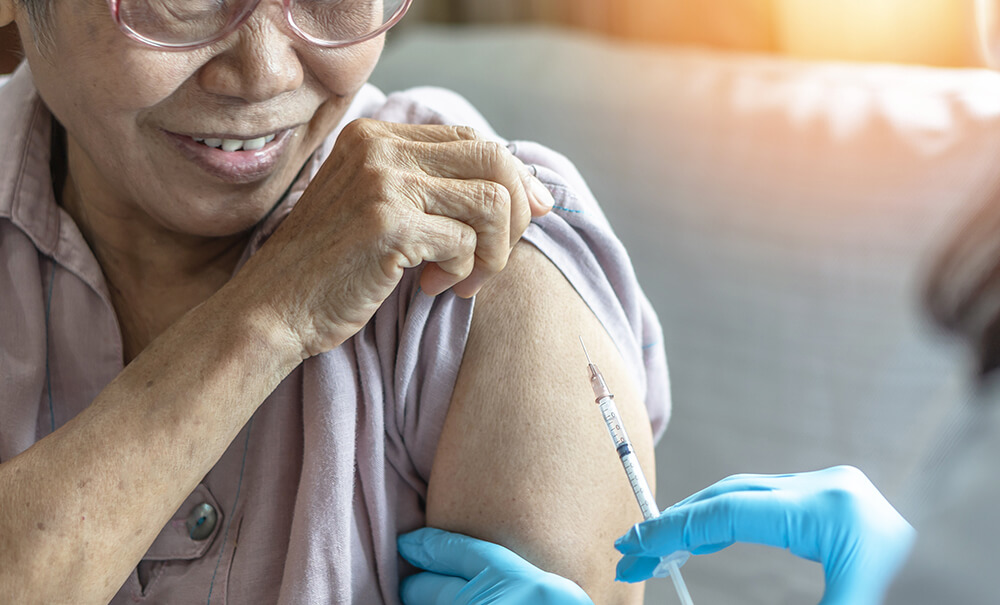As we get older, the risks associated with infectious diseases increase, due to reduced immunity and the increased likelihood of chronic diseases.
Coupled with the impact of COVID-19, urgent and sustainable solutions to ensure populations age healthily need to be explored. So crucial is healthy ageing that the United Nations has declared the years 2021-2030 as the Decade of Healthy Ageing.
A key part of healthy ageing is prevention, including life-course immunisation, which is immunisation at every stage of one’s life to prevent diseases and maximise health.
The benefits of life-course immunisation, especially among the elderly are clear:
- In low- and middle-income countries, for every USD$1 spent on vaccines, there was a return of USD$16 on costs associated with illness, such as treatment costs and productivity losses[2]
- In low- and middle-income countries, taking into account the broader economic impact of illness, vaccinations save USD$44 for every dollar spent1
- Influenza vaccination in the elderly has shown to have a 50% reduction in hospitalisations and a 45% reduction in mortality during flu seasons[3]
However, the true value of vaccination in Southeast Asia is yet to be recognised, as uptake rates beyond childhood remain low – falling significantly short of the 75% immunization target rate set by the World Health Organization. [4] For example, only 2% of Malaysians[5] only 20% of the elderly population in Thailand are vaccinated against influenza.[6]
Key challenges remain to integrate life-course immunisation as part of healthy ageing policies.

Recognising the importance of life-course immunisation
Recognising that life-course immunisation is an important part of healthy ageing enables implementation and access to life-course immunisation progammes

Awareness and education
Understanding sentiments and themes that influence vaccination uptake, to prompt practical solutions and specific concerns to address

Financing immunisation across the life-course
While recognising the importance of life-course immunisation is an important step, there is also an urgent need to identify sustainable financing and infrastructure for vaccine delivery
References:
[1] https://theaseanpost.com/article/southeast-asias-rapidly-ageing-population
[2] https://publichealth.jhu.edu/2016/expanding-use-of-vaccines-could-save-up-to-44-dollars-for-every-dollar-spent-study-suggests
[3] Torner N, et al. (2017). Costs associated with influenza-related hospitalization in the elderly. Hum Vaccin Immunother 13(2): 412-416.
[4] EU-ABC, KPMG, Sanofi and WPPF. (2021). ‘The Decade of Healthy Ageing in ASEAN: Role of Life-course Immunisation’. Available: https://healthyageingasean.org.
[5] H. H. Mydin. (2020) ‘Influenza vaccination important too.’ The New Straits Times. [Online]. Available: https://www.nst.com.my/opinion/letters/2020/12/651562/influenza-vaccination-important-too
[6] J. T. Owusu, P. Praphasiri, D. Ditsungnoen, G. Leetongin, et al. ‘Seasonal influenza vaccine coverage among high-risk populations in Thailand, 2010–2012.’ Vaccine. 2015;33(5):742-747.
[7] United Nations, Department of Economic and Social Affairs, Population Division (2019). Probabilistic Population Projections Rev. 1 based on the World Population Prospects 2019 Rev. 1. [Online]. Available: http://population.un.org/wpp/
[8] S. Aungkulanon, P.Y. Cheng, K. Kusreesakul, K. Bundhamcharoen, et al. ‘Influenza-associated mortality in Thailand, 2006–2011.’ Influenza and other respiratory viruses. 2015;9(6):298-304.
[9] S. Kiertiburanakul, W. Phongsamart, T. Tantawichien, W. Manosuthi, P. Kulchaitanaroaj. ‘Economic Burden of Influenza in Thailand: A Systematic Review.’ Inquiry. 2020;57:1-14.
[10] J. T. Owusu, P. Praphasiri, D. Ditsungnoen, G. Leetongin, et al. ‘Seasonal influenza vaccine coverage among high-risk populations in Thailand, 2010–2012.’ Vaccine. 2015;33(5):742-747.
[11] https://apps.who.int/iris/bitstream/handle/10665/336764/tha-epi-factsheet-2020-eng.pdf?sequence=1&isAllowed=y
